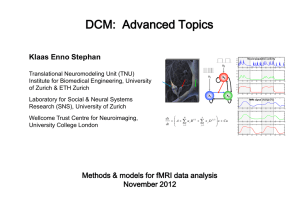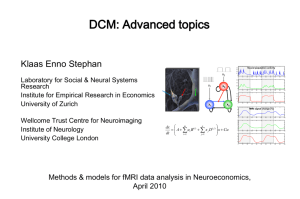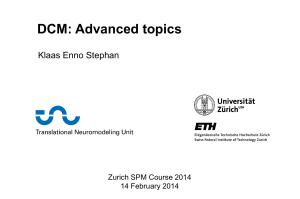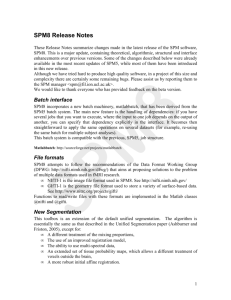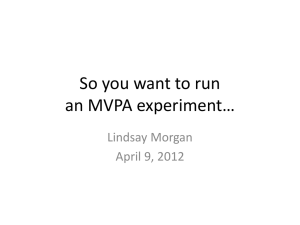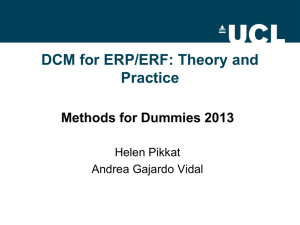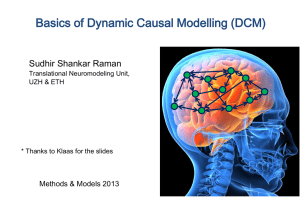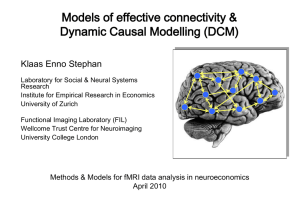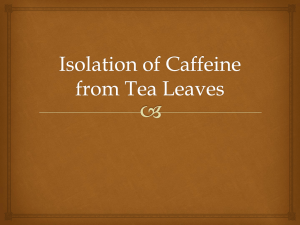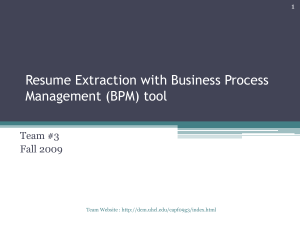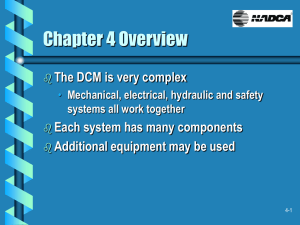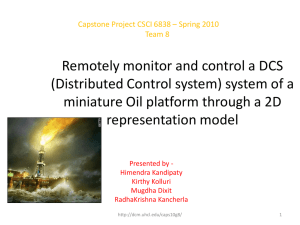Advanced topics - Foundations of Human Social
advertisement
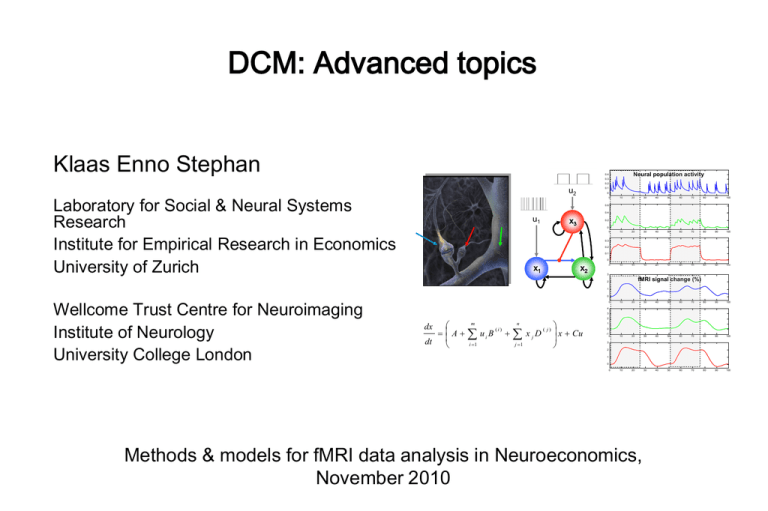
DCM: Advanced topics Klaas Enno Stephan Neural population activity 0.4 0.3 0.2 u2 Laboratory for Social & Neural Systems Research Institute for Empirical Research in Economics University of Zurich 0.1 0 0 10 20 30 40 50 60 70 80 90 100 0 10 20 30 40 50 60 70 80 90 100 0 10 20 30 40 50 60 70 80 90 100 0.6 0.4 u1 x3 0.2 0 0.3 0.2 0.1 0 x1 x2 3 fMRI signal change (%) 2 1 Wellcome Trust Centre for Neuroimaging Institute of Neurology University College London 0 0 10 20 30 40 50 60 70 80 90 100 0 10 20 30 40 50 60 70 80 90 100 0 10 20 30 40 50 60 70 80 90 100 4 3 A dt dx m i 1 n ui B (i) j 1 x jD ( j) x Cu 2 1 0 -1 3 2 1 0 Methods & models for fMRI data analysis in Neuroeconomics, November 2010 Dynamic Causal Modeling (DCM) Hemodynamic forward model: neural activityBOLD Electromagnetic forward model: neural activityEEG MEG LFP Neural state equation: dx F ( x , u, ) dt fMRI simple neuronal model complicated forward model EEG/MEG complicated neuronal model simple forward model inputs Overview • Bayesian model selection (BMS) • Extended DCM for fMRI: nonlinear, two-state, stochastic • Embedding computational models in DCMs • Integrating tractography and DCM Model comparison and selection Given competing hypotheses on structure & functional mechanisms of a system, which model is the best? Which model represents the best balance between model fit and model complexity? For which model m does p(y|m) become maximal? Pitt & Miyung (2002) TICS Bayesian model selection (BMS) Model evidence: p ( y | , m ) p ( | m ) d log p ( y | , m ) KL q , p | m p(y|m) p( y | m) Gharamani, 2004 y KL q , p | y , m all possible datasets accounts for both accuracy and complexity of the model allows for inference about structure (generalisability) of the model Various approximations, e.g.: - negative free energy, AIC, BIC McKay 1992, Neural Comput. Penny et al. 2004a, NeuroImage Approximations to the model evidence in DCM Maximizing log model evidence = Maximizing model evidence Logarithm is a monotonic function Log model evidence = balance between fit and complexity log p ( y | m ) accuracy ( m ) complexity ( m ) log p ( y | , m ) complexity ( m ) No. of parameters In SPM2 & SPM5, interface offers 2 approximations: Akaike Information Criterion: Bayesian Information Criterion: No. of data points AIC log p ( y | , m ) p BIC log p ( y | , m ) AIC favours more complex models, BIC favours simpler models. p log N 2 Penny et al. 2004a, NeuroImage The (negative) free energy approximation • Under Gaussian assumptions about the posterior (Laplace approximation), the negative free energy F is a lower bound on the log model evidence: log p ( y | m ) log p ( y | , m ) KL q , p | m KL q , p | y , m F KL q , p | y , m F log p ( y | m ) KL q , p | y , m The complexity term in F • In contrast to AIC & BIC, the complexity term of the negative free energy F accounts for parameter interdependencies. KL q ( ), p ( | m ) 1 2 ln C 1 2 ln C | y 1 2 |y T 1 C |y • The complexity term of F is higher – the more independent the prior parameters ( effective DFs) – the more dependent the posterior parameters – the more the posterior mean deviates from the prior mean • NB: SPM8 only uses F for model selection ! Bayes factors To compare two models, we could just compare their log evidences. But: the log evidence is just some number – not very intuitive! A more intuitive interpretation of model comparisons is made possible by Bayes factors: positive value, [0;[ B12 p ( y | m1 ) p( y | m2 ) Kass & Raftery classification: Kass & Raftery 1995, J. Am. Stat. Assoc. B12 p(m1|y) Evidence 1 to 3 50-75% weak 3 to 20 75-95% positive 20 to 150 95-99% strong 150 99% Very strong BMS in SPM8: an example attention M1 stim M1 M2 M3 M4 M3 stim PPC V1 attention V1 V5 PPC M2 M2 better than M1 BF 2966 F = 7.995 PPC attention stim V1 V5 M3 better than M2 BF 12 F = 2.450 V5 M4 attention PPC M4 better than M3 BF 23 F = 3.144 stim V1 V5 Fixed effects BMS at group level Group Bayes factor (GBF) for 1...K subjects: GBF ij BF (k ) ij k Average Bayes factor (ABF): A B Fij K BF (k ) ij k Problems: - blind with regard to group heterogeneity - sensitive to outliers Random effects BMS for heterogeneous groups Dirichlet parameters = “occurrences” of models in the population r ~ Dir ( r ; ) Dirichlet distribution of model probabilities r mk ~ p (mk | p ) mk ~ p (mk | p ) mk ~ p (mk | p ) m 1 ~ Mult ( m ;1, r ) y1 ~ p ( y1 | m 1 ) y1 ~ p ( y1 | m 1 ) y2 ~ p ( y2 | m2 ) y1 ~ p ( y1 | m 1 ) Multinomial distribution of model labels m Measured data y Model inversion by Variational Bayes (VB) or MCMC Stephan et al. 2009a, NeuroImage Penny et al. 2010, PLoS Comp. Biol. LD m2 MOG FG LD|LVF MOG FG LD|RVF MOG LD|LVF RVF stim. LD LD LG LVF stim. RVF LD|RVF stim. m2 Subjects MOG FG LD LG LG FG m1 LG LVF stim. m1 Data: Stephan et al. 2003, Science Models: Stephan et al. 2007, J. Neurosci. -35 -30 -25 -20 -15 -10 -5 Log model evidence differences 0 5 p(r >0.5 | y) = 0.997 1 5 4.5 4 p r1 r2 99 . 7 % m2 3.5 m1 p(r 1|y) 3 2.5 2 1.5 r1 84.3% r2 15.7% 0.5 0 0 1 11.8 2 2.2 1 0.1 0.2 0.3 0.4 0.5 r Stephan et al. 2009a, NeuroImage 0.6 1 0.7 0.8 0.9 1 nonlinear Model space partitioning: comparing model families log GBF 80 Summed log evidence (rel. to RBML) FFX linear 60 40 20 p(r >0.5 | y) = 0.986 1 0 5 CBMN CBMN(ε) RBMN RBMN(ε) CBML CBML(ε) RBML RBML(ε) RFX 12 4.5 10 4 m2 m1 alpha 8 3.5 p r1 r2 9 8 .6 % 6 3 p(r 1|y) 4 2 2.5 2 0 CBMN CBMN(ε) RBMN RBMN(ε) CBML CBML(ε) RBML RBML(ε) 1.5 1 16 14 12 m1 m2 4 8 1* k r2 2 6 .5 % r1 7 3 .5 % 0.5 0 0 10 alpha Model space partitioning 0.1 0.2 0.3 0.4 0.5 r k 1 0.6 0.7 0.8 0.9 1 1 6 4 8 2* k 2 k 5 0 nonlinear models linear models Stephan et al. 2009, NeuroImage Bayesian Model Averaging (BMA) • abandons dependence of parameter inference on a single model • uses the entire model space considered (or an optimal family of models) • computes average of each parameter, weighted by posterior model probabilities p n | y1 .. N p n | y n , m p m | y1 .. N m NB: p(m|y1..N) can be obtained by either FFX or RFX BMS • represents a particularly useful alternative – when none of the models (or model subspaces) considered clearly outperforms all others – when comparing groups for which the optimal model differs Penny et al. 2010, PLoS Comput. Biol. definition of model space inference on model structure or inference on model parameters? inference on individual models or model space partition? optimal model structure assumed to be identical across subjects? yes FFX BMS comparison of model families using FFX or RFX BMS inference on parameters of an optimal model or parameters of all models? optimal model structure assumed to be identical across subjects? yes no FFX BMS RFX BMS no RFX BMS Stephan et al. 2010, NeuroImage FFX analysis of parameter estimates (e.g. BPA) RFX analysis of parameter estimates (e.g. t-test, ANOVA) BMA Overview • Bayesian model selection (BMS) • Extended DCM for fMRI: nonlinear, two-state, stochastic • Embedding computational models in DCMs • Integrating tractography and DCM DCM10 in SPM8 • DCM version that was released as part of SPM8 in July 2010 (version 4010). • Introduces many new features, incl. two-state DCMs and stochastic DCMs • These features necessitated various changes, e.g. – – – – inputs mean-corrected prior variance of coupling parameters no longer dependent on number of areas simplified hemodynamic model self-connections: separately estimated for each area • For details, see: www.fil.ion.ucl.ac.uk/spm/software/spm8/SPM8_Release_Notes_r4010.pdf • Note: this is a different model from classical DCM! • When publishing papers, you should state whether you are using DCM10 or classical DCM (now referred to as DCM8). • If you don‘t know: DCM10 reveals its presence by printing a message to the command window. Factorial structure of model specification in DCM10 • Three dimensions of model specification: – bilinear vs. nonlinear – single-state vs. two-state (per region) – deterministic vs. stochastic • Specification via GUI. bilinear DCM non-linear DCM modulation driving input driving input modulation Two-dimensional Taylor series (around x0=0, u0=0): f f x f ( x , u ) f ( x 0 ,0 ) x u ux ... 2 ... dt x u xu x 2 dx Bilinear state equation: A dt dx (i) u i B x Cu i 1 m f f 2 2 2 Nonlinear state equation: A dt dx m uB i i 1 n (i) x j 1 j D ( j) x Cu Neural population activity 0.4 0.3 0.2 u2 0.1 0 0 10 20 30 40 50 60 70 80 90 100 0 10 20 30 40 50 60 70 80 90 100 0 10 20 30 40 50 60 70 80 90 100 0.6 u1 0.4 x3 0.2 0 0.3 0.2 0.1 0 x1 x2 3 fMRI signal change (%) 2 1 0 Nonlinear dynamic causal model (DCM) 0 10 20 30 40 50 60 70 80 90 100 0 10 20 30 40 50 60 70 80 90 100 0 10 20 30 40 50 60 70 80 90 100 4 3 A dt dx m uB n (i) i i 1 j 1 ( j) x j D x Cu 2 1 0 -1 3 2 1 Stephan et al. 2008, NeuroImage 0 attention MAP = 1.25 0.10 0.8 0.7 PPC 0.6 0.26 0.5 0.39 1.25 stim 0.26 V1 0.13 0.46 0.50 V5 0.4 0.3 0.2 0.1 0 -2 motion Stephan et al. 2008, NeuroImage -1 0 1 2 3 4 p ( D V 5 ,V 1 0 | y ) 99 . 1 % PPC 5 motion & attention static motion & no attention dots V1 V5 PPC observed fitted Two-state DCM Single-state DCM Two-state DCM input u E x1 E x1 x1 I x1 I x1 x x Cu ij ij exp( Aij uB ij ) x x Cu ij Aij uB ij 11 N 1 1N NN Marreiros et al. 2008, NeuroImage x1 x x N EE 11 IE 11 EE N1 0 11 EI 11 II 1N EE 0 NN EE 0 0 Extrinsic (between-region) coupling NN IE 0 0 EE NN II NN Intrinsic (within-region) coupling x1E I x1 x E xN xI N Estimates of hidden causes and states (Generalised filtering) Stochastic DCM inputs or causes - V2 1 dx 0.5 (A dt v u u jB j ( j) )x Cv (x) 0 -0.5 -1 0 200 (v) 400 600 800 1000 hidden states - neuronal 0.1 excitatory signal 0.05 • all states are represented in generalised coordinates of motion • random state fluctuations w(x) have unknown precision and smoothness two hyperparameters 1200 0 -0.05 -0.1 0 200 400 600 800 1000 1200 hidden states - hemodynamic 1.3 flow volume dHb 1.2 1.1 1 • fluctuations w(v) induce uncertainty about how inputs influence neuronal activity inputs u effectively serve as priors on the hidden neuronal causes 0.9 0.8 0 200 400 600 800 1000 1200 predicted BOLD signal 2 observed predicted 1 0 -1 -2 Li et al., submitted -3 0 200 400 600 time (seconds) 800 1000 1200 Overview • Bayesian model selection (BMS) • Extended DCM for fMRI: nonlinear, two-state, stochastic • Embedding computational models in DCMs • Integrating tractography and DCM Learning of dynamic audio-visual associations 1 Conditioning Stimulus CS1 Target Stimulus CS2 0.8 or p(face) or CS 0 Response TS 200 400 600 Time (ms) 800 0.6 0.4 0.2 2000 ± 650 0 0 200 400 600 trial den Ouden et al. 2010, J. Neurosci. 800 1000 Explaining RTs by different learning models Reaction times 1 True Bayes Vol HMM fixed HMM learn RW 450 0.8 430 p(F) RT (ms) 440 420 0.6 0.4 410 400 390 0.2 0.1 0.3 0.5 0.7 0.9 p(outcome) 0 400 0.7 • Rescorla-Wagner • Hidden Markov models (2 variants) 520 560 600 Bayesian model selection: 0.6 Exceedance prob. • hierarchical Bayesian learner 480 Trial 5 alternative learning models: • categorical probabilities 440 hierarchical Bayesian model performs best 0.5 0.4 0.3 0.2 0.1 0 Categorical model den Ouden et al. 2010, J. Neurosci. Bayesian learner HMM (fixed) HMM (learn) RescorlaWagner Hierarchical Bayesian learning model p k 1 k volatility vt-1 p v t 1 | v t , k ~ N v t , exp( k ) vt probabilistic association rt rt+1 observed events ut ut+1 p rt 1 | rt , v t ~ Dir rt , exp( v t ) 1 p red ictio n : p rt , v t , K u 1:t 1 rt 1 , v t 1 p v t v t 1 , K t p r t 1 u p d ate: p rt , v t , K u 1:t t t u 1:t 1 p u t rt d rt d v t d K Behrens et al. 2007, Nat. Neurosci. 0.6 0.4 p rt , v t , K u 1:t 1 p u t rt p r , v , K , v t 1 , K u 1:t 1 d rt 1 d v t 1 p(F) p r 0.8 0.2 0 400 440 480 520 Trial 560 600 Stimulus-independent prediction error Putamen Premotor cortex p < 0.05 (cluster-level wholebrain corrected) 0 -0.5 0 -0.5 -1 -1.5 -2 BOLD resp. (a.u.) BOLD resp. (a.u.) p < 0.05 (SVC) -1 -1.5 p(F) p(H) den Ouden et al. 2010, J. Neurosci . -2 p(F) p(H) Prediction error (PE) activity in the putamen PE during reinforcement learning O'Doherty et al. 2004, Science PE during incidental sensory learning den Ouden et al. 2009, Cerebral Cortex According to current learning theories (e.g., FEP): synaptic plasticity during learning = PE dependent changes in connectivity Plasticity of visuo-motor connections • Modulation of visuomotor connections by striatal prediction error activity Hierarchical Bayesian learning model PUT PMd • Influence of visual areas on premotor cortex: – stronger for surprising stimuli – weaker for expected stimuli den Ouden et al. 2010, J. Neurosci . p = 0.017 p = 0.010 PPA FFA Prediction error in PMd: cause or effect? Model 1 minus Model 2 5 4 Model 1 Model 2 log model evidence 3 2 1 0 -1 -2 -3 -4 1 2 3 4 5 6 7 8 9 10 11 12 13 14 15 subject p(r >0.5 | y) = 0.991 1 5 p(r 1|y) 4 3 2 1 0 0 den Ouden et al. 2010, J. Neurosci . 0.2 0.4 0.6 r 1 0.8 1 Overview • Bayesian model selection (BMS) • Extended DCM for fMRI: nonlinear, two-state, stochastic • Embedding computational models in DCMs • Integrating tractography and DCM Diffusion-weighted imaging Parker & Alexander, 2005, Phil. Trans. B Probabilistic tractography: Kaden et al. 2007, NeuroImage • computes local fibre orientation density by spherical deconvolution of the diffusion-weighted signal • estimates the spatial probability distribution of connectivity from given seed regions • anatomical connectivity = proportion of fibre pathways originating in a specific source region that intersect a target region • If the area or volume of the source region approaches a point, this measure reduces to method by Behrens et al. (2003) 1.6 Integration of tractography and DCM 1.4 1.2 1 R1 R2 0.8 0.6 0.4 0.2 0 -2 -1 0 1 2 low probability of anatomical connection small prior variance of effective connectivity parameter 1.6 1.4 1.2 1 R1 R2 0.8 0.6 0.4 0.2 0 Stephan, Tittgemeyer et al. 2009, NeuroImage -2 -1 0 1 high probability of anatomical connection large prior variance of effective connectivity parameter 2 Proof of concept study probabilistic tractography FG 34 6.5% FG left FG FG right 24 43.6% 13 15.7% LG left LG LG 12 34.2% LG right anatomical connectivity DCM connectionspecific priors for coupling parameters 6.5% v 0.0384 2 1.8 1 5 .7 % 1.6 v 0 .1 0 7 0 1.4 1.2 1 0.8 0.6 34.2% 43.6% v 0.5268 v 0.7746 0.4 Stephan, Tittgemeyer et al. 2009, NeuroImage 0.2 0 -3 -2 -1 0 1 2 3 Connection-specific prior variance as a function of anatomical connection probability ij 0 m 1: a=-32,b=-32 m 2: a=-16,b=-32 m 3: a=-16,b=-28 m 4: a=-12,b=-32 m 5: a=-12,b=-28 m 6: a=-12,b=-24 m 7: a=-12,b=-20 m 8: a=-8,b=-32 m 9: a=-8,b=-28 1 1 1 1 1 1 1 1 1 0.5 0.5 0.5 0.5 0.5 0.5 0.5 0.5 0.5 0 0 0 0 0 0 0 0 0 0 0.5 1 0 0.5 1 0 0.5 1 0 0.5 1 0 0.5 1 0 0.5 1 0 0.5 1 0 0.5 1 0 0.5 1 m 10: a=-8,b=-24 m 11: a=-8,b=-20 m 12: a=-8,b=-16 m 13: a=-8,b=-12 m 14: a=-4,b=-32 m 15: a=-4,b=-28 m 16: a=-4,b=-24 m 17: a=-4,b=-20 m 18: a=-4,b=-16 1 1 1 1 1 1 1 1 1 1 0 exp( ij ) 0.5 0.5 0.5 0.5 0.5 0.5 0.5 0.5 0.5 0 0 0 0 0 0 0 0 0 0 0.5 1 0 0.5 1 0 0.5 1 0 0.5 1 0 0.5 1 0 0.5 1 0 0.5 1 0 0.5 1 0 0.5 1 m 19: a=-4,b=-12 m 20: a=-4,b=-8 m 21: a=-4,b=-4 m 22: a=-4,b=0 m 23: a=-4,b=4 m 24: a=0,b=-32 m 25: a=0,b=-28 m 26: a=0,b=-24 m 27: a=0,b=-20 1 1 1 1 1 1 1 1 1 • 64 different mappings by systematic search across hyperparameters and 0.5 0.5 0.5 0.5 0.5 0.5 0.5 0.5 0 0 0 0 0 0 0 0 0 0 0.5 1 0 0.5 1 0 0.5 1 0 0.5 1 0 0.5 1 0 0.5 1 0 0.5 1 0 0.5 1 0 0.5 1 m 28: a=0,b=-16 m 29: a=0,b=-12 m 30: a=0,b=-8 m 31: a=0,b=-4 m 32: a=0,b=0 m 33: a=0,b=4 m 34: a=0,b=8 m 35: a=0,b=12 m 36: a=0,b=16 1 1 1 1 1 1 1 1 1 0.5 0.5 0.5 0.5 0.5 0.5 0.5 0.5 0.5 0 0 0 0 0 0 0 0 0 0 0.5 1 0 0.5 1 0 0.5 1 0 0.5 1 0 0.5 1 0 0.5 1 0 0.5 1 0 0.5 1 0 0.5 1 m 37: a=0,b=20 m 38: a=0,b=24 m 39: a=0,b=28 m 40: a=0,b=32 m 41: a=4,b=-32 m 42: a=4,b=0 m 43: a=4,b=4 m 44: a=4,b=8 m 45: a=4,b=12 1 1 1 1 1 1 1 1 1 0.5 • yields anatomically informed (intuitive and counterintuitive) and uninformed priors 0.5 0.5 0.5 0.5 0.5 0.5 0.5 0.5 0.5 0 0 0 0 0 0 0 0 0 0 0.5 1 0 0.5 1 0 0.5 1 0 0.5 1 0 0.5 1 0 0.5 1 0 0.5 1 0 0.5 1 0 0.5 1 m 46: a=4,b=16 m 47: a=4,b=20 m 48: a=4,b=24 m 49: a=4,b=28 m 50: a=4,b=32 m 51: a=8,b=12 m 52: a=8,b=16 m 53: a=8,b=20 m 54: a=8,b=24 1 1 1 1 1 1 1 1 1 0.5 0.5 0.5 0.5 0.5 0.5 0.5 0.5 0 0 0 0 0 0 0 0 0.5 0.5 0.5 0.5 0.5 0.5 0.5 0.5 0.5 0 0 0.5 1 0 0.5 1 0 0.5 1 0 0.5 1 0 0.5 1 0 0.5 1 0 0.5 1 0 0.5 1 0 0.5 1 m 55: a=8,b=28 m 56: a=8,b=32 m 57: a=12,b=20 m 58: a=12,b=24 m 59: a=12,b=28 m 60: a=12,b=32 m 61: a=16,b=28 m 62: a=16,b=32 m 63 & m 64 1 1 1 1 1 1 1 1 1 0 0 0.5 1 0 0 0.5 1 0 0 0.5 1 0 0 0.5 1 0 0 0.5 1 0 0 0.5 1 0 0 0.5 1 0 0.5 0 0.5 1 0 0 0.5 1 log group Bayes factor 600 400 200 log group Bayes factor 0 0 10 20 30 model 40 50 60 0 10 20 30 model 40 50 60 40 50 60 700 695 690 685 680 post. model prob. 0.6 0.5 0.4 0.3 Models with anatomically informed priors (of an intuitive form) 0.2 0.1 0 0 10 20 30 model m 1: a=-32,b=-32 m 2: a=-16,b=-32 m 3: a=-16,b=-28 m 4: a=-12,b=-32 m 5: a=-12,b=-28 m 6: a=-12,b=-24 m 7: a=-12,b=-20 m 8: a=-8,b=-32 m 9: a=-8,b=-28 1 1 1 1 1 1 1 1 1 0.5 0.5 0.5 0.5 0.5 0.5 0.5 0.5 0.5 0 0 0 0 0 0 0 0 0 0 0.5 1 0 0.5 1 0 0.5 1 0 0.5 1 0 0.5 1 0 0.5 1 0 0.5 1 0 0.5 1 0 0.5 1 m 10: a=-8,b=-24 m 11: a=-8,b=-20 m 12: a=-8,b=-16 m 13: a=-8,b=-12 m 14: a=-4,b=-32 m 15: a=-4,b=-28 m 16: a=-4,b=-24 m 17: a=-4,b=-20 m 18: a=-4,b=-16 1 1 1 1 1 1 1 1 1 0.5 0.5 0.5 0.5 0.5 0.5 0.5 0.5 0.5 0 0 0 0 0 0 0 0 0 0 0.5 1 0 0.5 1 0 0.5 1 0 0.5 1 0 0.5 1 0 0.5 1 0 0.5 1 0 0.5 1 0 0.5 1 m 19: a=-4,b=-12 m 20: a=-4,b=-8 m 21: a=-4,b=-4 m 22: a=-4,b=0 m 23: a=-4,b=4 m 24: a=0,b=-32 m 25: a=0,b=-28 m 26: a=0,b=-24 m 27: a=0,b=-20 1 1 1 1 1 1 1 1 1 0.5 0.5 0.5 0.5 0.5 0.5 0.5 0.5 0.5 0 0 0 0 0 0 0 0 0 0 0.5 1 0 0.5 1 0 0.5 1 0 0.5 1 0 0.5 1 0 0.5 1 0 0.5 1 0 0.5 1 0 0.5 1 m 28: a=0,b=-16 m 29: a=0,b=-12 m 30: a=0,b=-8 m 31: a=0,b=-4 m 32: a=0,b=0 m 33: a=0,b=4 m 34: a=0,b=8 m 35: a=0,b=12 m 36: a=0,b=16 1 1 1 1 1 1 1 1 1 0.5 0.5 0.5 0.5 0.5 0.5 0.5 0.5 0.5 0 0 0 0 0 0 0 0 0 0 0.5 1 0 0.5 1 0 0.5 1 0 0.5 1 0 0.5 1 0 0.5 1 0 0.5 1 0 0.5 1 0 0.5 1 m 37: a=0,b=20 m 38: a=0,b=24 m 39: a=0,b=28 m 40: a=0,b=32 m 41: a=4,b=-32 m 42: a=4,b=0 m 43: a=4,b=4 m 44: a=4,b=8 m 45: a=4,b=12 1 1 1 1 1 1 1 1 1 0.5 0.5 0.5 0.5 0.5 0.5 0.5 0.5 0.5 0 0 0 0 0 0 0 0 0 0 0.5 1 0 0.5 1 0 0.5 1 0 0.5 1 0 0.5 1 0 0.5 1 0 0.5 1 0 0.5 1 0 0.5 1 m 46: a=4,b=16 m 47: a=4,b=20 m 48: a=4,b=24 m 49: a=4,b=28 m 50: a=4,b=32 m 51: a=8,b=12 m 52: a=8,b=16 m 53: a=8,b=20 m 54: a=8,b=24 1 1 1 1 1 1 1 1 1 0.5 0.5 0.5 0.5 0.5 0.5 0.5 0.5 0.5 0 0 0 0 0 0 0 0 0 0 0.5 1 0 0.5 1 0 0.5 1 0 0.5 1 0 0.5 1 0 0.5 1 0 0.5 1 0 0.5 1 0 0.5 1 m 55: a=8,b=28 m 56: a=8,b=32 m 57: a=12,b=20 m 58: a=12,b=24 m 59: a=12,b=28 m 60: a=12,b=32 m 61: a=16,b=28 m 62: a=16,b=32 m 63 & m 64 1 1 1 1 1 1 1 1 1 0.5 0 0.5 0 0.5 1 0 0.5 0 0.5 1 0 0.5 0 0.5 1 0 0.5 0 0.5 1 0 0.5 0 0.5 1 0 0.5 0 0.5 1 0 0.5 0 0.5 1 0 0.5 0 0.5 1 0 0 0.5 1 Models with anatomically informed priors (of an intuitive form) were clearly superior than anatomically uninformed ones: Bayes Factor >109 Key methods papers: DCM for fMRI and BMS – part 1 • Chumbley JR, Friston KJ, Fearn T, Kiebel SJ (2007) A Metropolis-Hastings algorithm for dynamic causal models. Neuroimage 38:478-487. • Daunizeau J, David, O, Stephan KE (2011) Dynamic Causal Modelling: A critical review of the biophysical and statistical foundations. NeuroImage, in press. • Friston KJ, Harrison L, Penny W (2003) Dynamic causal modelling. NeuroImage 19:1273-1302. • Friston K, Stephan KE, Li B, Daunizeau J (2010) Generalised filtering. Mathematical Problems in Engineering 2010: 621670. • Kasess CH, Stephan KE, Weissenbacher A, Pezawas L, Moser E, Windischberger C (2010) Multi-Subject Analyses with Dynamic Causal Modeling. NeuroImage 49: 3065-3074. • Kiebel SJ, Kloppel S, Weiskopf N, Friston KJ (2007) Dynamic causal modeling: a generative model of slice timing in fMRI. NeuroImage 34:1487-1496. • Li B, Daunizeau J, Stephan KE, Penny WD, Friston KJ (2011). Stochastic DCM and generalised filtering. Submitted. • Marreiros AC, Kiebel SJ, Friston KJ (2008) Dynamic causal modelling for fMRI: a two-state model. NeuroImage 39:269-278. • Penny WD, Stephan KE, Mechelli A, Friston KJ (2004a) Comparing dynamic causal models. NeuroImage 22:1157-1172. • Penny WD, Stephan KE, Mechelli A, Friston KJ (2004b) Modelling functional integration: a comparison of structural equation and dynamic causal models. NeuroImage 23 Suppl 1:S264274. Key methods papers: DCM for fMRI and BMS – part 2 • Penny WD, Stephan KE, Daunizeau J, Joao M, Friston K, Schofield T, Leff AP (2010) Comparing Families of Dynamic Causal Models. PLoS Computational Biology 6: e1000709. • Stephan KE, Harrison LM, Penny WD, Friston KJ (2004) Biophysical models of fMRI responses. Curr Opin Neurobiol 14:629-635. • Stephan KE, Weiskopf N, Drysdale PM, Robinson PA, Friston KJ (2007) Comparing hemodynamic models with DCM. NeuroImage 38:387-401. • Stephan KE, Harrison LM, Kiebel SJ, David O, Penny WD, Friston KJ (2007) Dynamic causal models of neural system dynamics: current state and future extensions. J Biosci 32:129-144. • Stephan KE, Weiskopf N, Drysdale PM, Robinson PA, Friston KJ (2007) Comparing hemodynamic models with DCM. NeuroImage 38:387-401. • Stephan KE, Kasper L, Harrison LM, Daunizeau J, den Ouden HE, Breakspear M, Friston KJ (2008) Nonlinear dynamic causal models for fMRI. NeuroImage 42:649-662. • Stephan KE, Penny WD, Daunizeau J, Moran RJ, Friston KJ (2009a) Bayesian model selection for group studies. NeuroImage 46:1004-1017. • Stephan KE, Tittgemeyer M, Knösche TR, Moran RJ, Friston KJ (2009b) Tractography-based priors for dynamic causal models. NeuroImage 47: 1628-1638. • Stephan KE, Penny WD, Moran RJ, den Ouden HEM, Daunizeau J, Friston KJ (2010) Ten simple rules for Dynamic Causal Modelling. NeuroImage 49: 3099-3109. Thank you
